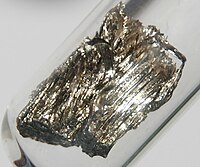
Photo from wikipedia
Abstract Cubic, terraced, and spherical Mg-MgO nanoparticles (NPs), ranging in average particle size from 30 up to 80 nm, were prepared through vaporization and condensation of Mg metal in mix gas… Click to show full abstract
Abstract Cubic, terraced, and spherical Mg-MgO nanoparticles (NPs), ranging in average particle size from 30 up to 80 nm, were prepared through vaporization and condensation of Mg metal in mix gas flow (argon + air) at conditions of the levitation-jet aerosol synthesis. These NPs were collected in three zones, located at different distances from an evaporator. Scanning electron microscopy (SEM), X-ray diffraction (XRD), BET measurements, UV–Vis, FT-IR, Raman, XPS, and vibrating-sample magnetometry (VSM) were used for characterized of NPs. The results indicated an essential effect of synthesis conditions on the nanoparticle properties. Room temperature ferromagnetism with the maximum magnetization of up to 0.65 emu/g was found in the nanoparticles. The maximum specific magnetization of the NPs depends on the value of specific surface area multiplied by oxide content in the form of two-peaks function. It was discovered a clear increase in the maximum magnetization of NPs, collected in the different zones, with an increase in the distance of these zones from the evaporator. It was suggested that the observed ferromagnetic ordering may be related to the Mg-deficient defects on the surface of NPs. This suggestion was in agreement with the results of optical experiments, particularly, with an increase in the Raman peak intensities. In addition, XPS studies reveal an oscillating quenching dependence of the maximum magnetization on Mg 2p peak width value. It was also supposed that various values of the maximum magnetization origin from the different fabrication conditions promoting defects propagation on the surface of NPs.
Journal Title: Journal of Alloys and Compounds
Year Published: 2018
Link to full text (if available)
Share on Social Media: Sign Up to like & get
recommendations!